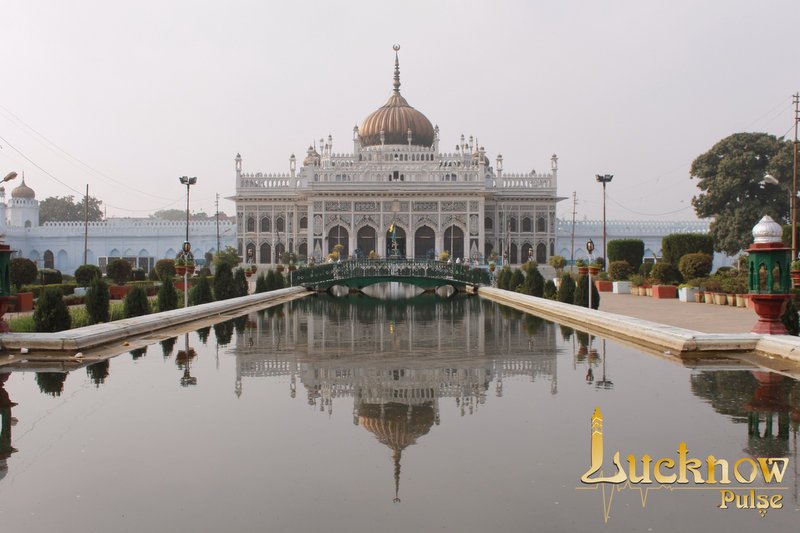Lucknow has transformed beyond recognition over the past years but what hasn’t changed is the city’s rich architectural heritage. One such magnificent monument is the Chota Imambara Lucknow. Also known as the Hussainabad Imambara, it is an edifice of the most imposing grandeur and rare beauty. It was built by Muhammad Ali Shah, third King of Awadh after he was placed on the throne by the British forces upon agreeing to follow any and every treaty forwarded by the Governor General. This exquisite monument is also known as the Palace of Lights owing to the chandeliers decorated inside which when lit on special occasions lend the most beautiful glow to the building. It was built in order to serve as a mausoleum for Muhammad Ali Shah and his family members.
The architecture of the Chota Imambara in Lucknow is a mixture of Indian, Persian and Islamic design and is one of the finest architectural wonders of the Nawabi era. The Imambara does not stand alone but is a part of a larger complex which comprises of a Main Hall, a mosque, Naubat Khana (guard-house where drums were beaten six times a day), a stable, two miniatures of Taj Mahal, a water channel with gardens on both sides and two entrance gateways. Muhammad Ali Shah began the construction of the Hussainabad Imambara in the second year of his reign. He also ordered the construction of a mosque which was supposed to surpass the magnificence and grandeur of the Jama Masjid in Delhi.
It was Muhammad Ali’s most cherished dream to convert Lucknow into the Babylon of India and leave an immortal memorial for himself which would represent him as the greatest ruler of all times. The result of this was the Hussainabad Imambara and its complex. He even deposited a sum of twelve lakhs rupees with the East India Company for the upkeep of his beloved Imambara. The building was so beautiful that it is said that the Sibtainabad Imambara was made into the image of the Chota Imambara and when illuminated in Muharram, it fills Lucknow with lights.
The Main Hall of the Hussainabad Imambara is built on a rectangular platform and is known as Azakhana. An Azakhana is a place where people assemble for mourning the dead martyrs, usually in the month of Muharram. It is in the Main hall that the tombs of the King Muhammad Ali Shah and his mother also lie. One of the most striking features of the Main Hall is the gold plated domes on the roof. The beautiful turrets and minarets along with the splendid gold dome can be seen from a distance and they together appear to be inviting the visitor for a closer look.
The outer walls of the Main Hall are a showcase of the exquisite Lucknowi art that is calligraphy. The black walls have religious verses engraved upon them in white and this making the Imambara even more unique.The inner hall is decorated with beautiful crystal chandeliers and lamp stands along with European gilt-edged mirrors, the royal throne and crown along with a variety of Tazias (these are miniature imitations of the mausoleums of Karbala and are used in ritual processions held in the month of Muharram).The pillars and walls of the Main Hall are adorned with Quranic verses written in calligraphic style along with numerous local and imported antiques and artifacts.
Upon entering, the first thing that a visitor might notice is the two lightning conductors which have been placed in the form of two woman statues, placed on the either the sides of the gate. Also, the tomb of Muhammad Ali Shah’s daughter, Zeenat-un-Nisa lies beneath one of the two miniature Taj Mahal lookalikes. The other miniature was built merely to maintain a symmetrical design, a style which was very popular with the Mughals.
Outside the Imambara is the Satkhanda, which literally means tower of seven storeys, however, the tower stands only four storey tall as its construction was stopped midway due to the death of the king. Its purpose would have been to serve as a watchtower and lunar observatory. Inspired by the Mughals, the Nawabs also included many gardens and water channels in their monuments and Chota Imambara can boast of one such beautiful garden and water channel complete with fountains that are believed were once connected to the Gomti River. The Hussainabad Imambara is truly exceptional and is a must-see monument on a visit to Lucknow. One can visit the Imambara anytime between Sunrise to Sunset.
Written by: Fatima Siddiqui



Comment here